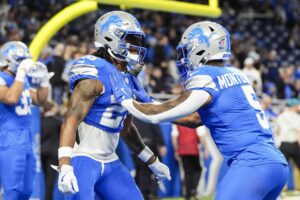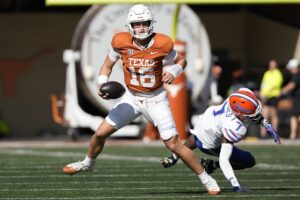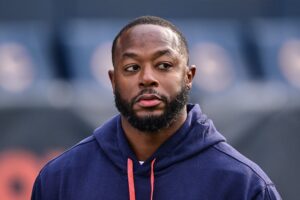It goes without saying that the Tom Brady/Bill Belichick New England Patriots had an unprecedented stretch of dominance. They put up great season after great season, and as a result, some of their seasons have gone under the historical radar. Most people will, rightfully, talk about the dominance of the 2004, 2007, 2014, and 2016 teams, but there were many amazing Patriots teams that do not get enough attention. Of all the renditions of dominant Patriot teams, the 2010 New England Patriots squad might be the most underrated.
The Dominance of the 2010 New England Patriots
On the Surface
In 2010, the Patriots led the league with 32.4 points per game and went 14-2. They had the best record in football and ranked first in both offensive and total DVOA by pretty large margins. Quarterback Tom Brady won the first-ever unanimous MVP, throwing 36 touchdowns to just four interceptions. While this is incredibly good, even for the Patriots, this team does not get that much historical attention. However, they were one of the most unique and dominant teams in NFL history. What differentiates this team, and why are they overlooked?
Surrounded by Mystery
Coming off a disappointing 2009 campaign that was punctuated by a 33-14 blowout loss to the Ravens, there were a lot of question marks heading into the 2010 season. Many questioned whether Brady, coming off a good but inconsistent year, could truly return to form. Among skill position players, Wes Welker was the only guy who was not surrounded by mystery.
At that point, it was apparent that the legendary Randy Moss had lost a lot of his athleticism. They signed seven-time Pro Bowler Torry Holt, but he was well past his prime and was not a lock to make the roster. In an attempt to remedy this situation, they turned to the draft. They selected Rob Gronkowski, Aaron Hernandez, and Taylor Price in hopes of injecting their pass-catching group with youth. Brandon Tate was drafted in 2009, but he was also another young receiver that was expected to contribute.
Figuring Things Out
Holt was cut in the preseason, and Moss was shipped to the Minnesota Vikings as a result of some disagreements with the Patriots coaching staff. Despite some of these issues, the Patriots started off strong. They won three of their first four games, but things weren’t quite perfect and they needed a veteran to replace Moss. Enter Deion Branch. After being traded to the Seahawks for a first-round pick in 2006, the former Patriots receiver was somewhat underwhelming in his time with Seattle. However, Belichick liked what he saw and reacquired him for a third-round pick. This trade set up the Patriots for great success down the road.
Throughout the first half of the season, the Patriots offense was really good. Brady was averaging 0.19 EPA/play, good for fourth in the NFL, and the offense as a whole ranked second in the NFL with 0.13 EPA/play. However, this was nothing compared to the stretch of dominance that they were about to embark on. Coming off of a disappointing 34-14 defeat to the Cleveland Browns, the Patriots traveled to Heinz Field in an attempt to right the ship on Sunday Night Football.
Beating the Best
Against the Pittsburgh Steelers, who ended up representing the AFC in the Super Bowl, the Patriots offense broke out and never looked back. Brady threw for 350 yards and three touchdowns, averaging 0.41 EPA/play. This was Rob Gronkowski’s true breakout game, as he was on the receiving end of all three of Brady’s touchdowns. The Patriots won 39-26.
This Steelers game started a stretch in which the Patriots consistently beat some of the best teams in football. In that time, they convincingly defeated the Super Bowl Champion Green Bay Packers, the AFC Champion Steelers, AFC South Champion Indianapolis Colts, NFC North champion Chicago Bears, and Wild Card winner New York Jets. Both the Jets and Bears advanced to their respective conference championships that year.
Their dominance over elite teams was not limited to that six-game stretch. They also defeated the Baltimore Ravens, who went 12-4 and won a playoff game, and the San Diego Chargers, who led the league with both the most offensive yards and fewest defensive yards. Needless to say, they squared off with their fair share of good teams.
Subheading
From weeks 10-17, Tom Brady averaged 0.39 EPA/play, far and away the best in football, 0.08 points above Aaron Rodgers, who ranked second. The Patriots rushing offense ranked third in EPA/play over that span, just a couple ticks behind the Jacksonville Jaguars and Philadelphia Eagles. After some fairly significant early-season struggles, the defense stepped up too. On the back of a turnover heavy, aggressive approach, they managed to completely turn things around. After giving up 0.17 EPA/play in the first nine weeks, good for 27th in the league, they jumped down to allowing an impressive -0.08 EPA/play the rest of the way, third-best in all of football. That combination of dominant offense and opportunistic defense boded well for New England, as during that stretch they went 8-0 with ease.
An Unusual Approach
Despite reaching incredible offensive heights, Brady attempted just 492 passes, the second-lowest full-season total of his career. As a whole, the Patriots attempted just 53 more passes than runs. Running backs BenJarvus Green-Ellis and Danny Woodhead both totaled more scrimmage yards than any Patriots receiver or tight end. While it is generally unwise to run the ball so much, it worked for the Patriots.
The Patriots offense fumbled just nine times in 2010, fewest in the league. More importantly, their running backs fumbled just twice. As a result, despite ranking just 10th in yards per attempt, their rushing offense ranked first in the entire NFL with 0.1 EPA/play. Avoiding turnovers is probably one of the few ways a running back can truly add value, and the Patriots took that idea and ran with it.
On offense, the Patriots had the fewest fumbles lost, interceptions, and, well, total turnovers of any team in the league. They did this while also forcing the most interceptions on defense, along with the second-most total turnovers. They did, in fact, manage to win the vaunted turnover battle. All of this was accomplished while still averaging the fourth-most yards per play on offense.
The Bitter End
No one really knows what happened on Sunday, January 15th, 2011. The Patriots had the ball early on and looked primed to score. Then, all of a sudden, Brady sailed a pass intended for Green-Ellis and was intercepted by David Harris, who took the ball and ran it back inside the Patriots red zone. However, the Jets didn’t even take advantage of this error. Kicker Nick Folk missed the subsequent field goal wide left.
It didn’t matter. The Patriots offense was off in a big way. Brady was unable to get on the same page with his receivers, especially on third down. It always felt like they were on the verge of getting things going, but they never had a breakthrough. Miscommunications, errant throws, and dropped passes in key situations plagued them all game. The Jets ended up winning 28-21 and ending New England’s magical season. All in all, their Divisional Round defeat to the Jets was one of the worst moments in the Brady/Belichick era.
One of the Greatest
As a result of not winning the Super Bowl, this Patriots team is always overlooked. They went 14-2, had the third-best offensive DVOA in NFL History (2007 Patriots rank first), and had some of the finest performances in NFL history. They were chock full of exciting young talent on both offense and defense, having an impressive combination of dominance and fun, not to mention that this was the season that Brady grew his hair out. Bonus points for that. The 2010 Patriots are right up there with the 1998 Vikings as one of the very best teams to not make a Super Bowl.






